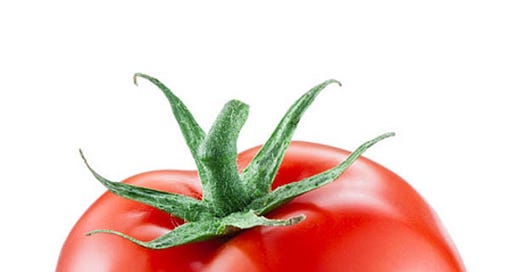Is it too late to give this summer another title? We’re still living through Brat Summer, Glen Powell Summer, and the ever present and annual Hot Girl Summer, but one crucial element is missing. For the last few years, a fruit or vegetable has taken centre stage and become the legume du jour (d’été?); last year it was a Tomato Girl Summer, and before that strawberries adorned every conceivable surface (personally I think Hailey Bieber was a little behind the times when she said 2023 was strawberry girl summer, but who am I to disagree with such a prominent cultural voice). Particularly last year, this way of defining an aesthetic—food-noun girl summer—really took off.
While we may not be linking our style and behaviours to the vibe of a vegetable so much this year, the idea has rumbled along in the background. It’s a combination of the girl-ism that’s dominated the zeitgeist over the past year or so, the ongoing affection for microtrends, and the decisions of the fashion lords to place certain items of food in vogue.
I hate to bring this up to anyone who has elected to forget the era, but it wasn’t long ago that the world was overrun with bacon-themed clothing and accessories. The Wikipedia page for Bacon Mania is unpleasantly fascinating, if you feel like going down a rabbit hole. The early 2010s were big on food-trends-on-clothing. Alongside the bacon paraphernalia sat avocado outfits, sushi sweatshirts, and of course anything related to pizza. It was all part of the wider cultural picture at the time, of course, not a fashion-exclusive phenomenon, but these kinds of items were especially visible in the growing world of fast fashion.
Fast forward a few years, and the scene has changed somewhat. Now, rather than a visually direct connection there’s a more loose link to whatever the popular food is. It’s a starting point to jump off of, a way to assign yourself an identity and subscribe to a certain clique, a way of life. If you’re a matcha latte girl then you wear soft greens and have a slicked back bun, you use a MacBook and you have perfect handwriting. Everything is clean and perfect. Or maybe you’re a tomato girl, living life in the Italian countryside wearing natural fabrics, dappled in sunlight and holding a wicker basket over your arm. Whatever you choose, the food itself is far from the focal point; its essence and associations curate a way of life. Rather than owning the bacon accessory, the bacon accessory owns you.
Food-related trends are the perfect combination for marketers; not only do you sell the food and flavour itself—strawberries, strawberry-flavoured foodstuffs, strawberry-flavoured weight-loss supplements sold as #girlboss empowerment health powders etc etc—but by selling its very image. Its vibe. They also highlight the intense connection between womanhood and food.
It’s an oversimplification, and not exclusive to women, but we’re made to be aware of what we’re consuming from a very young age. How young were you when you first started noticing diet adverts? Posters with a disembodied toned torso telling you that if you buy this product, that torso could be yours—as if it came as a free toy in the cereal box. There’s been a lot said about diet culture, disordered eating, eating disorders and everything related to our relationship with food in recent years, the upshot being that it’s not great. People are starting to realise that, hey, maybe all those years of aggressive messaging to change your body and appearance were a little damaging. Maybe they went just a teensy bit too far.
There’s been at least something of reduction in how much of this stuff is expressly pedalled these days, but like a shapeshifting gremlin it will never relinquish its hold on society. Now we’ve got ‘wellness’ trends based on misinformation or straight-up lies that people follow religiously, perpetuate and pass on; there’s an intense focus on gut health and the microbiome; and people are taking any number of supplements rather than have real food. The fact that you can get your greens in a powder rather than just… eating a vegetable… becomes more ridiculous the longer you think about it*.
And these food-girl trends, they’re just repackaged versions of the same old stories. You’ll notice that ‘bacon girl’ is not a frontrunning trend. Who wants to be associated with bacon—greasy, salty and fatty—when you can have the freshness and lightness of a berry or an overpriced pastel-toned drink? You don’t want to base your lifestyle around the concept of bacon. You want to worship at the temple of Big Matcha. Drink this, and it will change your life. You can be like the girl on the Pinterest moodboard or the torso on the cereal box if you just consume what you’re told to.
In day-to-day life these things aren’t all that serious. It can be eye-roll-inducing to see brands jump on food-girl trends because they’re stupid, and another sign of how grassroots aesthetic ideas are co opted by corporations and turned into exercises of consumption. But beyond the frivolity of it all there’s the same underlying message that you need to change.
According to some incredible brief research (one Google search), mushrooms were predicted as being ‘in’ this year (as a fungi fan I very much approve of this). Perhaps the next big food-girl trend will be mushroom-girl autumn; we can all wear beige and brown and learn to communicate through mycelial networks.
*especially when the powder in question costs SEVENTY NINE POUNDS A MONTH!



